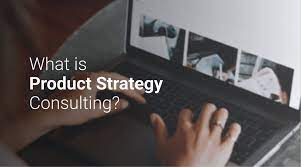Because of their limited budgets and resources, startups prioritize product development over research and planning. However, researching the market and target audience and developing a product strategy and roadmap allows you to create a product that remains financially viable in the long term. In this article, you’ll discover how to make a product strategy that propels your firm to market success.
What is a product strategy?
Product strategies are high-level plans for attaining company goals with a specific product. A product strategy lets you prioritize your roadmap and use your available time and resources the most.
The strategy integrates your company goals with the future product and helps you develop a how-to plan for obtaining your desired result.
How can you create a successful product strategy Consultation?
Step one: define your market.
The most effective technique to create a product strategy consultation is to research your target market.
- Who are your customers?
- What do they need?
- What do they want?
- What problems do they face?
- Will they pay to remedy these issues?
Steve Blank suggests identifying a market based on Jobs-to-Be-Done in his customer development approach. This method would be ideal for firms with a clear product concept. As a result, this strategy defines your market as an individual group.
Jobs-to-be-Done identifies potential customers and describes their needs. Also, it tells you who your competitors are and how to keep your clients happy. As a result, it fits neatly into the current portion of the product strategy.
Step 2: Define customer personas.
Who are you building your product for? There are two main ways to figure it out:
- Imagine your ideal customer: Create detailed profiles of typical users, including their needs, wants, and personalities. Think of them as fake people you design to represent real customers.
- Focus on the tasks people want to do: Instead of a specific customer, consider the jobs people need to get done. Then, see your product as a tool that helps them accomplish those tasks. This can help you find a broader range of customers who might benefit from what you’re building.
Step 3: Outline the issues.
Lots of startups jump straight to ideas without really understanding the problems people face. The key is to figure out the most significant pain points for your target customers. Not all problems are created equal. You need to find the ones that are most important to both your customers and your business.
Step 4: Define Product Goals
Product strategy consulting execution is brutal without outlining key goals. These are the goals you want to achieve by developing a product. We advocate SMART goals. SMART stands for specific, measurable, achievable, realistic, and time-bound.
Step 5: What are your products’ differentiators?
- Quality: Your product is more reliable and high-quality than its rivals.
- Pricing: Customers prefer your product’s price and pricing plan over rivals’.
- Design: Your product is more practical, trendy, fashionable, and inventive.
- Service and interactions: You provide better help, individualized customer interactions, and a novel method of processing client requests, increasing customer satisfaction.
- Features: Your product does something that your rivals cannot, performs faster, or is the only one that offers unique features to this audience.
- Customization: Users may tailor your items to their needs to a degree that no other product offers.
Step 6: Determine success measures.
To assess the real success of your product, you need actionable KPIs (key performance indicators) to monitor. Your KPIs will vary depending on the type of product and its objectives. Paid subscription applications, for example, must keep track of the number of subscriber subscriptions every month and the number of monthly active subscribers and unsubscribers. On the other hand, websites that monetize with ads are more likely to measure page views, registered visitors, ad clicks, and other metrics.
Step 7: Create a solid product vision.
Your product vision defines the positive impact your product should have. It explains why the product should exist and shows you how to create a product strategy consulting consistent with your company’s values. Vision is usually expressed as a brief statement or slogan. The vision statement should be well described and meet specific criteria:
- It must be simple to grasp and remember.
- It should be aspirational, giving your team a broader understanding of why they are working on this project.
- It should be actionable, not tactical. Your objective must be genuine and reachable in many ways.
If you have a compelling product idea and understand your product’s fundamental value, you may begin developing a product strategy consulting based on the vision statement. However, only establish your vision after understanding your market and user personas. Your product needs to offer something rivals do not. Your vision statement will direct product strategy consulting and identify techniques for reaching your company’s objectives.
Step 8: Generate a feature breakdown list.
After establishing the market, value proposition, differentiators, and company objectives, we build a feature breakdown list (FBL). An FBL whitepaper shows the key characteristics of the initial product release.
We recommend beginning with epics, which may be split into features. An epic combines characteristics connected to a task to be completed (the user case). Take note that each epic comprises unique scenarios for various user roles. The document structure may be altered depending on the project’s complexity and degree of realism. You may create more layers to categorize features from larger to smaller objects.
Step 9: Visualize Your Product Strategy.
Summarizing all data, ideas, and consumables is critical for conveying your product strategy consultation to stakeholders. Here’s how to create a product strategy canvas that is easy to understand
Final thoughts.
CodeSuite product managers understand how to create a product strategy for a business and help it become a market leader. This is more than just copying rivals. We will also help you identify and eliminate possible hazards throughout the product’s early phases. Contact us for product strategy consulting services.
